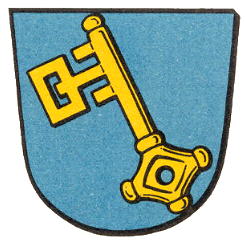Kettenbach: Difference between revisions
Jump to navigation
Jump to search
Knorrepoes (talk | contribs) m (Text replacement - "/Arms of " to "/Arms (crest) of ") |
Knorrepoes (talk | contribs) m (Text replacement - "{{media}}" to " {{de1}} {{media1}}") |
||
| Line 12: | Line 12: | ||
The arms are based on the oldest known seal of the village, known from 1781-1788. The key is the symbol of St. Peter, the local patron saint. The colours are those of [[Nassau]], as the village belonged to Nassau from 1326 until the 17th century and again in the 18th century. The seals made in the 19th century simply showed the name of the village. | The arms are based on the oldest known seal of the village, known from 1781-1788. The key is the symbol of St. Peter, the local patron saint. The colours are those of [[Nassau]], as the village belonged to Nassau from 1326 until the 17th century and again in the 18th century. The seals made in the 19th century simply showed the name of the village. | ||
{{ | |||
{{de1}} | |||
{{media1}} | |||
[[Civic Heraldry Literature - Germany|'''Literature''']]: Hessisches Wappenbuch, 1956 | [[Civic Heraldry Literature - Germany|'''Literature''']]: Hessisches Wappenbuch, 1956 | ||
Revision as of 11:05, 26 December 2022
This page is part of the German heraldry portal |
Heraldry of the World |
|
German heraldry:
|
Selected collector's items from Germany:
|
KETTENBACH
State : Hessen
District (Kreis) : Rheingau-Taunus Kreis (until 1973 Untertaunuskreis)
Incorporated into : 1971 Aarbergen
Origin/meaning
The arms are based on the oldest known seal of the village, known from 1781-1788. The key is the symbol of St. Peter, the local patron saint. The colours are those of Nassau, as the village belonged to Nassau from 1326 until the 17th century and again in the 18th century. The seals made in the 19th century simply showed the name of the village.
Literature: Hessisches Wappenbuch, 1956


